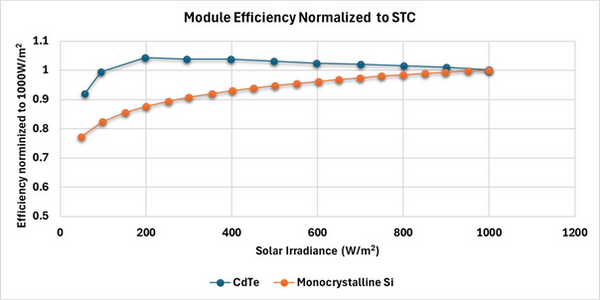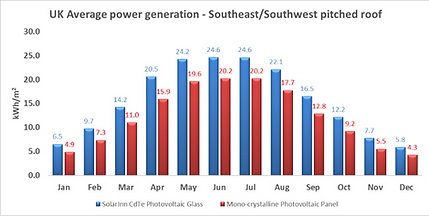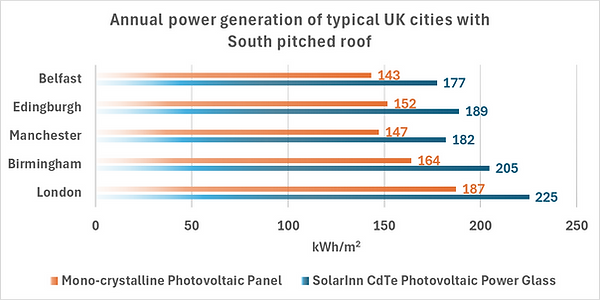Exceptional low-light performance
1. Module Efficiency Comparison (mono-crystalline Silicon VS CdTe)
In low-light conditions such as early morning or late evening, Modernité outperforms conventional crystalline silicon cells, generating 15.7% more power at 200 W/m². This extended operating time means more energy output throughout the day and across the year, with up to 30–40% higher annual yield compared to traditional products, and even greater gains on east and west façades.

Fig. 1 Module Efficiency Normalized to STC
Note: STC (Irradiance: 1000 W/m², Cell Temperature: 25 °C, Spectrum: AM 1.5)
2. Pitched Roof Power Generation Comparison
(mono-crystalline Silicon VS CdTe)
SolarInn CdTe Photovoltaic Glass generates 25–30% more energy annually than mono-crystalline PV on pitched roofs. Unlike conventional panels that lose efficiency in winter and non-south orientations, CdTe delivers stable, uniform performance all year round. With superior low-light response and reduced orientation sensitivity, it is the ideal solution for the UK’s diffuse-light climate.

South Pitched Roof

East/West Pitched Roof

Southeast/Southwest Pitched Roof

Northeast/Northwest Pitched Roof

North Pitched Roof

Annual UK Average Pitched Roof Power Generation
3. Facade Power Generation Comparison
(mono-crystalline Silicon VS CdTe)
SolarInn CdTe Photovoltaic Glass delivers 25–30% higher annual energy yield than mono-crystalline PV when installed on façades. Unlike conventional panels that suffer sharp losses on non-south orientations, CdTe maintains stable generation across south, east/west, and even north-facing façades. With superior diffuse-light performance and reduced orientation sensitivity, it turns every building façade into a reliable and elegant source of clean energy.

South Facade

East/West Facade

Southeast/Southwest Facade

Northeast/Northwest Facade

North Facade

Annual UK Average Facade Power Generation
4. Facade Power Generation Comparison
(mono-crystalline Silicon VS CdTe)
Across major UK cities, SolarInn CdTe Photovoltaic Glass consistently outperforms mono-crystalline PV panels. In London, it achieves 225 kWh/m² annually, compared to only 187 kWh/m² from mono-crystalline — a 20% gain. Similar advantages are seen in Birmingham (+25%), Manchester (+24%), Edinburgh (+24%), and Belfast (+24%).
This clear performance edge is driven by CdTe’s superior response to diffuse and low-light conditions, ensuring higher, more stable yields in the UK’s cloudy and variable climate. For developers, architects, and property owners, this means greater energy returns and enhanced building value, without compromise on design or reliability.

5. Power Generation in various applications
With SolarInn CdTe technology, power generation is directly linked to transparency. High-transparency applications such as solar windows, skylights, and greenhouses allow more daylight penetration, offering balanced energy generation with natural lighting. Low-transparency products like roof panels or black façades achieve the highest yields, exceeding 200 kWh/m²/year on south-facing installations. This flexibility means architects and developers can choose the right balance between visibility and electricity output, turning every surface — from clear glass to opaque façades — into a tailored clean energy solution. The lower the transparency, the higher the energy output — but every option delivers value.
